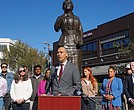City’s housing options need a dose of creativity
6/9/2022, 6 p.m.
One of the biggest challenges facing Richmond is how to build affordable apartment units and homes.
By affordable, think households with incomes of $51,000 a year or less.
According to the U.S. Census Bureau’s estimate, $51,000 is the current median household income within the city, meaning half of the city’s households have incomes above that figure and half have incomes below.
More than 25,000 units of less expensive housing is needed for those in the lower half of the income scale, and the community is falling woefully short in reaching that number.
What we know is that the current method of creating housing that suits households with less money is not really a solution.
Take Virginia Supportive Housing. It plans to spend at least $23 million creating 86 units of new housing for individuals in Richmond’s former nursing home on Cool Lane. Think about that. When you divide 86 into $23 million, VSH will spend $267,441 per unit.
While the end product may be affordable for those who will live there, that is pretty expensive for VSH. The nonprofit needed a lot of help, mostly from the government, to build this project. And when it costs so much to create a unit, it takes time, often two to three years, to put the financing package in place.
In other words, you don’t crank out two, three or four of these projects every year.
And VSH is not alone. Plans for transforming public housing into mixed-income communities are based on spending $250,000 or more per unit – as evidenced by the $70 million that has been poured into the development of the award-winning Armstrong Renaissance in the East End to create 220 classy apartment units and 36 new homes.
The same kind of costs are envisioned for the impending redevelopment of Creighton Court and the transformation of Gilpin Court near downtown on which community discussions have begun.
There has to be a better way to get more units built faster and at a lower price point.
Fortunately, there are wonderful models, despite the lack of attention in this area.
For example, Auburn University’s Rural Studio has spent the past 20 years learning how to create radically affordable, well- designed 550-square foot homes – largely to improve the housing of residents of Alabama’s impoverished Black Belt. Before the spike in building costs, the homes they built cost $20,000 from start to finish.
Even if such homes would cost $40,000 to build today due to the spike in material costs, they would still be a bargain.
There are others who have been experimenting with ways to build using nonstandard materials that are cheaper, but strong and durable, that never get a look in the Richmond area, where advocates appear to spend a lot of time wringing their hands about the situation while offering little of the kind of practical solutions being tested elsewhere.
More energy also is needed to eliminate the zoning barriers that City Hall and neighboring counties have installed to block residential density and prevent various types of well-designed, but less expensive homes from being developed.
Soaring property values here and across the country are making the situation more urgent and more dire. Before another overpriced high rise goes up in an area many workers can’t afford, we encourage city planners and developers to be creative as they pursue housing options for retail clerks, waiters, janitors, certified nursing assistants, secretaries and other hard-working people on the lower end of the income scale.
The blueprint is clear. It is time to end lip service about affordable housing. Let’s get busy and find ways to make it happen.






